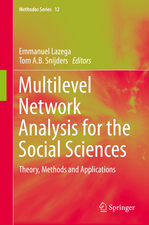Statistical Analysis of Network Data: Methods and Models: Springer Series in Statistics
Autor Eric D. Kolaczyken Limba Engleză Hardback – 19 mar 2009
| Toate formatele și edițiile | Preț | Express |
|---|---|---|
| Paperback (1) | 707.64 lei 6-8 săpt. | |
| Springer – 6 dec 2010 | 707.64 lei 6-8 săpt. | |
| Hardback (1) | 1000.70 lei 6-8 săpt. | |
| Springer – 19 mar 2009 | 1000.70 lei 6-8 săpt. |
Din seria Springer Series in Statistics
- 14%
 Preț: 679.60 lei
Preț: 679.60 lei - 20%
 Preț: 630.97 lei
Preț: 630.97 lei - 20%
 Preț: 816.43 lei
Preț: 816.43 lei - 20%
 Preț: 1000.84 lei
Preț: 1000.84 lei -
 Preț: 390.84 lei
Preț: 390.84 lei - 20%
 Preț: 697.13 lei
Preț: 697.13 lei - 20%
 Preț: 445.20 lei
Preț: 445.20 lei - 20%
 Preț: 884.68 lei
Preț: 884.68 lei - 18%
 Preț: 1237.14 lei
Preț: 1237.14 lei - 18%
 Preț: 961.82 lei
Preț: 961.82 lei - 18%
 Preț: 956.50 lei
Preț: 956.50 lei - 18%
 Preț: 794.25 lei
Preț: 794.25 lei - 15%
 Preț: 648.05 lei
Preț: 648.05 lei - 18%
 Preț: 1217.10 lei
Preț: 1217.10 lei - 15%
 Preț: 646.11 lei
Preț: 646.11 lei - 15%
 Preț: 647.08 lei
Preț: 647.08 lei - 15%
 Preț: 646.11 lei
Preț: 646.11 lei - 18%
 Preț: 1329.76 lei
Preț: 1329.76 lei - 15%
 Preț: 652.81 lei
Preț: 652.81 lei - 18%
 Preț: 1114.52 lei
Preț: 1114.52 lei - 18%
 Preț: 952.40 lei
Preț: 952.40 lei - 18%
 Preț: 1333.42 lei
Preț: 1333.42 lei - 18%
 Preț: 1561.68 lei
Preț: 1561.68 lei - 18%
 Preț: 1231.47 lei
Preț: 1231.47 lei - 15%
 Preț: 513.64 lei
Preț: 513.64 lei - 18%
 Preț: 893.71 lei
Preț: 893.71 lei - 15%
 Preț: 649.87 lei
Preț: 649.87 lei - 18%
 Preț: 1007.65 lei
Preț: 1007.65 lei - 18%
 Preț: 1111.67 lei
Preț: 1111.67 lei - 18%
 Preț: 1223.70 lei
Preț: 1223.70 lei - 18%
 Preț: 892.74 lei
Preț: 892.74 lei - 18%
 Preț: 913.26 lei
Preț: 913.26 lei - 18%
 Preț: 943.88 lei
Preț: 943.88 lei -
 Preț: 391.61 lei
Preț: 391.61 lei -
 Preț: 391.22 lei
Preț: 391.22 lei - 18%
 Preț: 1331.18 lei
Preț: 1331.18 lei -
 Preț: 390.84 lei
Preț: 390.84 lei - 18%
 Preț: 888.45 lei
Preț: 888.45 lei - 18%
 Preț: 960.61 lei
Preț: 960.61 lei - 18%
 Preț: 1245.34 lei
Preț: 1245.34 lei - 18%
 Preț: 964.54 lei
Preț: 964.54 lei - 15%
 Preț: 643.16 lei
Preț: 643.16 lei - 18%
 Preț: 1723.76 lei
Preț: 1723.76 lei - 15%
 Preț: 643.84 lei
Preț: 643.84 lei - 15%
 Preț: 586.37 lei
Preț: 586.37 lei - 18%
 Preț: 999.59 lei
Preț: 999.59 lei - 15%
 Preț: 643.34 lei
Preț: 643.34 lei - 18%
 Preț: 806.40 lei
Preț: 806.40 lei - 18%
 Preț: 727.66 lei
Preț: 727.66 lei
Preț: 1000.70 lei
Preț vechi: 1250.88 lei
-20% Nou
Puncte Express: 1501
Preț estimativ în valută:
191.48€ • 199.92$ • 158.48£
191.48€ • 199.92$ • 158.48£
Carte tipărită la comandă
Livrare economică 04-18 aprilie
Preluare comenzi: 021 569.72.76
Specificații
ISBN-13: 9780387881454
ISBN-10: 038788145X
Pagini: 386
Ilustrații: XII, 386 p.
Dimensiuni: 155 x 235 x 23 mm
Greutate: 0.79 kg
Ediția:2009
Editura: Springer
Colecția Springer
Seria Springer Series in Statistics
Locul publicării:New York, NY, United States
ISBN-10: 038788145X
Pagini: 386
Ilustrații: XII, 386 p.
Dimensiuni: 155 x 235 x 23 mm
Greutate: 0.79 kg
Ediția:2009
Editura: Springer
Colecția Springer
Seria Springer Series in Statistics
Locul publicării:New York, NY, United States
Public țintă
ResearchCuprins
and Overview.- Preliminaries.- Mapping Networks.- Descriptive Analysis of Network Graph Characteristics.- Sampling and Estimation in Network Graphs.- Models for Network Graphs.- Network Topology Inference.- Modeling and Prediction for Processes on Network Graphs.- Analysis of Network Flow Data.- Graphical Models.
Recenzii
From the reviews:
“…Accessible and easy to read…strikes a balance between concepts and mathematical detail. …This book is a superb introduction to a fascinating area.” (International Statistical Review, 2010, 78, 1, 134-159) “Many disciplines are nowadays involved in network modeling, but it appears as if a common methodological foundation is lacking. The objective of this book is to provide a first attempt at defining such a common methodological foundation from a statistical point of view. … The style of the writing is excellent. … ample references allow quick access to further literature. I can recommend this book to anyone with a serious statistical interest in networks.” (Fred van Eeuwijk, VOC Nieuwsbrief, Issue 44, May, 2010)
“Any reader interested in networks and wanting a perspective beyond that of any single discipline should acquire this book. … Researchers will also appreciate the many points in the book where important open problems are identified. The book can also serve readily and flexibly as the main textbook for either a graduate-level seminar course or for an informally organized reading group. … This book sets itself the challenge of addressing statistics for network science broadly, and in the many ways already noted, it is successful.” (Michael Frey, Technometrics, Vol. 54 (1), February, 2012)
“…Accessible and easy to read…strikes a balance between concepts and mathematical detail. …This book is a superb introduction to a fascinating area.” (International Statistical Review, 2010, 78, 1, 134-159) “Many disciplines are nowadays involved in network modeling, but it appears as if a common methodological foundation is lacking. The objective of this book is to provide a first attempt at defining such a common methodological foundation from a statistical point of view. … The style of the writing is excellent. … ample references allow quick access to further literature. I can recommend this book to anyone with a serious statistical interest in networks.” (Fred van Eeuwijk, VOC Nieuwsbrief, Issue 44, May, 2010)
“Any reader interested in networks and wanting a perspective beyond that of any single discipline should acquire this book. … Researchers will also appreciate the many points in the book where important open problems are identified. The book can also serve readily and flexibly as the main textbook for either a graduate-level seminar course or for an informally organized reading group. … This book sets itself the challenge of addressing statistics for network science broadly, and in the many ways already noted, it is successful.” (Michael Frey, Technometrics, Vol. 54 (1), February, 2012)
Textul de pe ultima copertă
In the past decade, the study of networks has increased dramatically. Researchers from across the sciences—including biology and bioinformatics, computer science, economics, engineering, mathematics, physics, sociology, and statistics—are more and more involved with the collection and statistical analysis of network-indexed data. As a result, statistical methods and models are being developed in this area at a furious pace, with contributions coming from a wide spectrum of disciplines.
This book provides an up-to-date treatment of the foundations common to the statistical analysis of network data across the disciplines. The material is organized according to a statistical taxonomy, although the presentation entails a conscious balance of concepts versus mathematics. In addition, the examples—including extended cases studies—are drawn widely from the literature. This book should be of substantial interest both to statisticians and to anyone else working in the area of ‘network science.’
The coverage of topics in this book is broad, but unfolds in a systematic manner, moving from descriptive (or exploratory) methods, to sampling, to modeling and inference. Specific topics include network mapping, characterization of network structure, network sampling, and the modeling, inference, and prediction of networks, network processes, and network flows. This book is the first such resource to present material on all of these core topics in one place.
Eric Kolaczyk is a professor of statistics, and Director of the Program in Statistics, in the Department of Mathematics and Statistics at Boston University, where he also is an affiliated faculty member in the Center for Biodynamics, the Program in Bioinformatics, and the Division of Systems Engineering. His publications on network-based topics include work ranging from the detection of anomalous traffic patterns in computer networks to the prediction of biological function in networks ofinteracting proteins to the characterization of influence of groups of actors in social networks.
This book provides an up-to-date treatment of the foundations common to the statistical analysis of network data across the disciplines. The material is organized according to a statistical taxonomy, although the presentation entails a conscious balance of concepts versus mathematics. In addition, the examples—including extended cases studies—are drawn widely from the literature. This book should be of substantial interest both to statisticians and to anyone else working in the area of ‘network science.’
The coverage of topics in this book is broad, but unfolds in a systematic manner, moving from descriptive (or exploratory) methods, to sampling, to modeling and inference. Specific topics include network mapping, characterization of network structure, network sampling, and the modeling, inference, and prediction of networks, network processes, and network flows. This book is the first such resource to present material on all of these core topics in one place.
Eric Kolaczyk is a professor of statistics, and Director of the Program in Statistics, in the Department of Mathematics and Statistics at Boston University, where he also is an affiliated faculty member in the Center for Biodynamics, the Program in Bioinformatics, and the Division of Systems Engineering. His publications on network-based topics include work ranging from the detection of anomalous traffic patterns in computer networks to the prediction of biological function in networks ofinteracting proteins to the characterization of influence of groups of actors in social networks.
Caracteristici
Unified presentation of statistical models and methods from across the variety of disciplines engaged in ‘network science’ Balanced presentation of concepts and mathematics Examples, including extended case studies, drawn widely from applications in the literature Includes supplementary material: sn.pub/extras


























